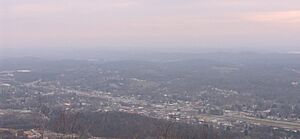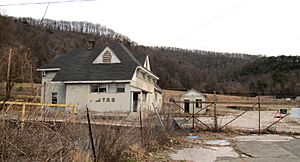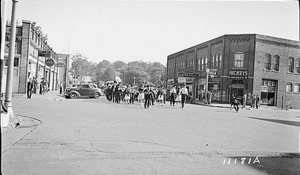Rockwood, Tennessee facts for kids
Quick facts for kids
Rockwood, Tennessee
|
|
|---|---|
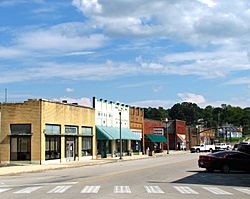
Rockwood Street
|
|
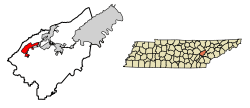
Location of Rockwood in Roane County, Tennessee.
|
|
| Country | United States |
| State | Tennessee |
| County | Roane |
| Founded | 1868 |
| Incorporated | 1890 |
| Named for | William O. Rockwood |
| Area | |
| • Total | 8.04 sq mi (20.83 km2) |
| • Land | 8.02 sq mi (20.76 km2) |
| • Water | 0.03 sq mi (0.08 km2) |
| Elevation | 892 ft (272 m) |
| Population
(2020)
|
|
| • Total | 5,444 |
| • Density | 679.23/sq mi (262.25/km2) |
| Time zone | UTC-5 (Eastern (EST)) |
| • Summer (DST) | UTC-4 (EDT) |
| ZIP code |
37854
|
| Area code(s) | 865 |
| FIPS code | 47-64440 |
| GNIS feature ID | 1299838 |
Rockwood is a city located in Roane County, Tennessee, in the United States. In 2010, about 5,562 people lived there. It is part of the larger Harriman area.
Contents
Exploring Rockwood's Location
Rockwood is found at coordinates 35.869147, -84.675176. The city sits at the bottom of the eastern side of the Cumberland Plateau. This area is known locally as Walden Ridge. The line that divides the Eastern Time Zone and the Central Time Zone runs right along the western edge of Rockwood.
The Watts Bar Lake, which is part of the Tennessee River, forms most of Rockwood's southern border. The city is built around several roads that connect with U.S. Route 70. This main road runs between State Route 29 in the northeast and State Route 27 to the southwest.
In recent years, Rockwood has grown towards Interstate 40 in the northeast. If you travel on I-40 between Knoxville and Nashville, you can see amazing views of Rockwood and the Tennessee Valley. These views appear just before the interstate reaches the top of the Cumberland Plateau.
The United States Census Bureau says that Rockwood covers a total area of about 7.9 square miles (20.83 square kilometers). Most of this area, about 7.9 square miles (20.76 square kilometers), is land. Only a small part, about 0.1 square miles (0.08 square kilometers), is water.
People of Rockwood
| Historical population | |||
|---|---|---|---|
| Census | Pop. | %± | |
| 1880 | 1,011 | — | |
| 1890 | 2,305 | 128.0% | |
| 1900 | 2,899 | 25.8% | |
| 1910 | 3,660 | 26.3% | |
| 1920 | 4,652 | 27.1% | |
| 1930 | 3,808 | −18.1% | |
| 1940 | 3,981 | 4.5% | |
| 1950 | 4,272 | 7.3% | |
| 1960 | 5,345 | 25.1% | |
| 1970 | 5,259 | −1.6% | |
| 1980 | 5,687 | 8.1% | |
| 1990 | 5,348 | −6.0% | |
| 2000 | 5,774 | 8.0% | |
| 2010 | 5,562 | −3.7% | |
| 2020 | 5,444 | −2.1% | |
| 2023 (est.) | 5,635 | 1.3% | |
| Sources: | |||
Rockwood's Population in 2020
In 2020, the 2020 United States census counted 5,444 people living in Rockwood. There were 2,129 households and 1,175 families in the city.
The people living in Rockwood come from different backgrounds:
| Group | Number of People | Percentage |
|---|---|---|
| White (not Hispanic) | 4,710 | 86.52% |
| Black or African American (not Hispanic) | 227 | 4.17% |
| Native American | 22 | 0.4% |
| Asian | 37 | 0.68% |
| Pacific Islander | 1 | 0.02% |
| Other/Mixed | 315 | 5.79% |
| Hispanic or Latino | 132 | 2.42% |
Rockwood's Past: A Look at History
Early Days of Rockwood
Long ago, a Cherokee village stood where Rockwood is now. This village was led by Chief Tallentuskie, an important Cherokee leader in the late 1700s and early 1800s.
The Roane Iron Company's Story
During the American Civil War, a Union general named John T. Wilder noticed that the Cumberland Plateau area had lots of iron ore and coal. After the war, in 1867, General Wilder and Hiram Chamberlain bought land in what is now Rockwood. They chose this spot because of the iron and coal, its closeness to the Tennessee River, and the belief that railroads would soon come through.
Wilder and Chamberlain, along with other investors, started the Roane Iron Company. By late 1868, they had built a large furnace that could make 15 tons of iron each day. This furnace was located between Walden Ridge and the end of what is now Rockwood Street.
The company mined coal and iron ore from the ridge. They used small trains to bring these materials to the furnace. The coal was turned into coke, which is a special fuel. The coke was then used to heat the iron ore and turn it into pig iron. This pig iron was then sent by river to factories in Knoxville and Chattanooga. It was mainly used to build railroads.
The Roane Iron Company hired local workers, both white and African-American, and also immigrants, especially from Wales. The company treated all workers fairly when it came to pay. The company closed down in 1929 after some mining accidents made it too difficult to continue.
How Rockwood Grew
General Wilder wanted to name the company town after one of the investors, William O. Rockwood, to make it seem less like a Union-led project. William Rockwood didn't play a huge role, so Wilder and Chamberlain did most of the work to develop the town. Unlike some other towns that grew very quickly, Rockwood grew steadily. Its population went from 696 people in 1870 to 2,305 by 1890.
In 1890, the Roane Iron Company held a big land sale in Rockwood. They sold many lots and earned a lot of money. To help the city grow, they built new streets and hotels. They also allowed other stores to open and compete with the company's own store. These changes helped Rockwood survive a tough economic time in 1893, which caused problems for nearby towns.
Rockwood in the 1900s
In the early 1900s, Rockwood's economy became more varied. James Tarwater, who used to work for Roane Iron, started Rockwood Mills in 1905, which made socks. Another former Roane Iron employee, Sewell Howard, started Rockwood Stove Works in 1916.
On October 4, 1926, a sad event happened when a mine explosion killed twenty-eight people in the area.
After the Roane Iron Company closed in 1929, many people in Rockwood lost their jobs. But when World War II began, the Tennessee Products Corporation reopened the iron works. They started making a special type of iron for the war effort. Rockwood's economy also got a boost from the government building the nearby city of Oak Ridge during World War II.
Famous People from Rockwood
- Harry T. Burn (1895–1977): He was a Tennessee lawmaker who helped pass the Nineteenth Amendment to the United States Constitution. This amendment gave women the right to vote in the United States. He also worked as the president of the First National Bank of Rockwood for many years.
- Christian H. Cooper (born 1976): He is a financial expert and a member of important groups like the Council on Foreign Relations.
- Nancy-Ann DeParle (born 1956): She is an expert on health care and used to lead the White House Office of Health Reform.
- C. M. Newton (1930-2018): He was a famous basketball player, coach, and manager. He is a member of the Basketball Hall of Fame.
Images for kids
See also
 In Spanish: Rockwood (Tennessee) para niños
In Spanish: Rockwood (Tennessee) para niños


